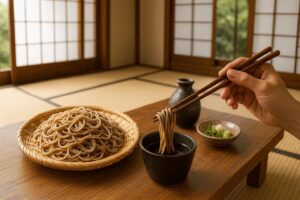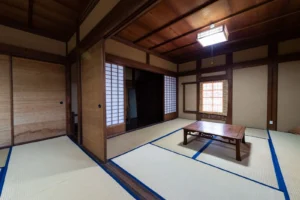Last Updated on 2025年7月28日 by Kenty
Japanese Etiquette Explained (With Surprising Truths!)
If you’ve ever visited a ramen shop in Japan, you’ve probably heard it—
SSSSLUUURP!
That loud noodle-slurping sound might surprise many Western visitors. But here’s the big question:
👉 Is it rude to slurp noodles in Japan?
Spoiler: Not at all. In fact, it might even be polite.
In this fun and practical guide, we’ll explore the truth about noodle slurping and go beyond that to cover other key aspects of Japanese etiquette—like taking off your shoes, bowing, and even how to exchange business cards.
🍜 Slurping Noodles: Yes, It’s Culturally Acceptable
In Japan, slurping ramen, soba, and udon is not just accepted—it’s often seen as a sign that you’re enjoying your meal.
✅ Why do people slurp?
- It cools down hot noodles while eating
- It enhances the flavor by mixing air with broth
- It shows appreciation to the chef (like saying “yum!”)
❌ When is slurping not okay?
- In formal settings or high-end restaurants (kaiseki-style)
- When eating non-noodle dishes (e.g., rice, curry)
🎌 Pro Tip: If you’re unsure, just look around and follow what locals are doing.
👟 Removing Shoes Indoors: Respect & Cleanliness
One of the first cultural differences travelers notice in Japan is the practice of removing shoes before entering homes—and sometimes even certain restaurants, temples, or schools.
🧦 When to remove shoes:
- Homes
- Traditional ryokan inns
- Some restaurants with tatami floors
- Shrines and temples
- Fitting rooms in clothing stores
🎒 Bring clean socks! Worn-out or holey socks are a no-go in Japan.
🙇♂️ Bowing: More Than Just a Greeting
Bowing (ojigi) in Japan is a complex form of non-verbal communication. It can mean hello, thank you, I’m sorry, or excuse me—depending on the situation and angle.
🎯 Types of bows:
| Type | Meaning | Angle |
|---|---|---|
| Light bow | Casual greeting | ~15° |
| Polite bow | Standard etiquette | ~30° |
| Deep bow | Apology or deep respect | 45°+ |
🙅♀️ Avoid handshakes unless offered first. Many Japanese prefer bowing over physical contact, especially with strangers.
💼 Exchanging Business Cards (Meishi)
In professional settings, business card exchange is almost ritualistic in Japan. If you’re doing business here—even casually—knowing the basics will make a good impression.
✍️ Basic etiquette:
- Use both hands when giving and receiving a card
- Bow slightly while exchanging
- Take a moment to read the card (don’t pocket it right away!)
- Place it gently on the table during meetings
🚫 Don’t write on or fold someone’s card in front of them—it’s seen as disrespectful.
🙊 Bonus: Other Quick Cultural Tips
✅ Don’t talk loudly on trains (and never on your phone)
✅ Queue properly—at elevators, trains, even escalators!
✅ Use both hands when giving/receiving items (gifts, change, etc.)
✅ Say “itadakimasu” before eating and “gochisousama” after meals
✅ Don’t tip—tipping is not common in Japan and can cause confusion
✨ Final Thoughts
Japanese etiquette might seem complex at first, but don’t worry about being perfect. Most Japanese people are very forgiving and appreciate when visitors make an effort.
So next time you visit a ramen shop in Tokyo and wonder,
“Should I slurp this?”
Yes—go ahead. Slurp with confidence, and enjoy your bowl like a local!





